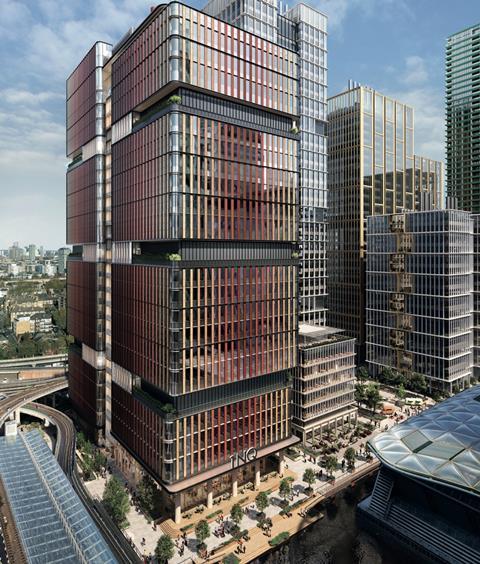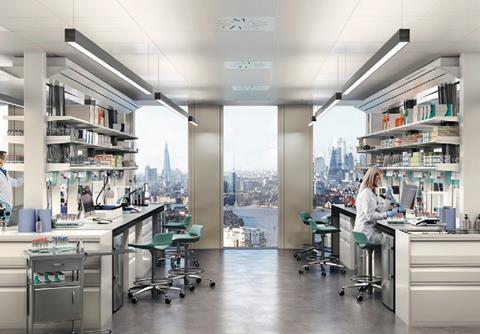What does Canary Wharf’s proposed life-sciences tower say about the booming property subsector? Christopher Walker investigates
Canary Wharf, an experiment of the 1980s to create a new banking district to the east of the City of London, is on a mission to reinvent itself – and benefit from the booming demand for life-science space.
Plans are afoot to develop a world-class life-sciences hub. A planning application has been submitted for a 23-storey, 823,000sqft tower on North Quay, adjacent to the new London Underground Elizabeth line. The site also recently achieved outline planning consent for 3.5m sqft of life-science space.
Richard Archer, managing director of offices at Canary Wharf Group, says: “The building will set a new benchmark in both the quality and scale of life-sciences laboratories and workspace, creating a first-of-its-kind vertical campus, which will be Europe’s largest and most technologically advanced life-sciences facility.”
The transformative project is the brainchild of life-science specialist real estate developer Kadans Science Partner, which was acquired by AXA IM Alts in 2020. “We see this partnership with Kadans as a significant opportunity,” says John O’Driscoll, co-head of the real estate business division at AXA IM Alts. “By bringing together high-quality capital with the leading team, we are able to look at bigger and more ambitious projects such as Canary Wharf.”
Kadans was in discussions with Canary Wharf Group for some time, according to Kadans CEO Michel Leemhuis, who describes it as “the most important life-science development in Europe”. He says: “Of all the cities we have looked at in Europe, London is the most interesting place at present. It is very difficult to find a location in London, and certainly it would be impossible to think of something on the scale of [what] we’re doing, anywhere other than Canary Wharf.”
Leemhuis says it is “a very high-quality building” with “high design values”, because “we speak the scientists’ language”. He argues it is not just transforming an office building – it is effectively being designed from scratch. The height has certainly meant specific challenges – for example, in the distribution of gases, or where to locate air-handling installations which condition and distribute air.
The speculative development has certainly attracted attention within the institutional real estate industry at a time when life sciences has been one of the most sought-after sectors among investors.
Douglas Crawshaw, global head of real estate manager research at Willis Towers Watson, says: “The attempt to repurpose Canary Wharf is very ambitious, given the huge amount of space involved.”
Emma Goodford, head of life sciences and innovation at Knight Frank, says: “There’s no question that life-science space can be developed in schemes which are high rise or more ‘ground scraper’ in style. Canary Wharf has a significant advantage in that its connectivity is much better than, say, King’s Cross.”
However, she adds a word of caution. “If you think of the three crucial requirements for successful life-science real estate, namely: one, proximity to academia and research institutes; two, proximity to National Health Service [NHS] research hospitals and their data; and, three, existing life-science companies in place, then there are some issues to consider for the developers of Canary Wharf.”

Having said that, Goodford says “the scale of investment and expertise of those investing, makes this a proposition to watch very closely”. Last year, Genomics England announced it was moving its headquarters to Canary Wharf this autumn, as part of the development of a major life-science cluster. Moves like this “will support the evolution of this location”, says Goodford.
Leemhuis says: “What we are doing is creating a new innovation hub. There’s no question this is a speculative development, because there are no existing life-science companies in that area, nor is it immediately next to a university. But our attitude is ‘build it and they will come’. We intend to have a healthy mix of young start-ups, scale-ups and established companies. We are seeing considerable interest from all these groups.”
There are significant advantages to Canary Wharf, according to Leemhuis. It is well connected with three major transport routes – the Jubilee line, the Elizabeth line and the Docklands Light Railway. It is the only life-science location with a direct link to London Heathrow airport, something that is very important for US tenants. There is also a short travel time to King’s Cross, another life-science hub, arguably enabling it to claim to be part of the Oxford-Cambridge-London ‘golden triangle’.

Kadans is also doing more than just offering tenants space. Leemhuis says: “We are adding significant ancillary services and support programmes, creating an entire ecosystem around the new development. We know what we are doing. We have been developing life-science real estate since 2009 and I would say we are very much the European market leader.”
It is noteworthy that Kadans has undertaken similar developments in the Netherlands, including the 19,000sqm Plus Ultra Leiden, a speculative project that was delivered last year and now is 92% occupied. It also developed the 22,000sqm Accelerator Utrecht, which is fully occupied. Kadans is also developing a “fully speculative”, 25,000sqm project at Villejuif in the suburbs of Paris.
The UK moving the fastest
The background to the Canary Wharf development is the surging demand for life-science space generally. Crawshaw says: “The pandemic concentrated everyone’s mind on the importance of this sector to the economy. At the moment, everyone wants to invest here and there simply aren’t enough buildings. That could make the returns for early movers exciting.”
This is particularly so in the UK market, according to O’Driscoll. “The UK is an extremely attractive market for life-science real estate investors because of the government’s strong commitment to building the knowledge economy,” he says. “There is a high level of funding in research and development, and the capital-raising markets are increasingly open to life-science companies.”
There is also a very good talent pool in the UK. Leemhuis says: “Fortunately for the UK, there is a lot of high-quality scientific talent.” At the same time the demand trend is growing. There has been a huge inflow of venture capital and a number of spinouts from the UK universities, much more than elsewhere in Europe.
Goodford agrees with Crawford: “Since the pandemic there has been a wave of interest catalysed by the significant demand potential from much of the science developing in response to the pandemic.”
And she adds to O’Driscoll’s list of UK advantages. It has in Oxford and Cambridge, two of the highest-ranked universities in the world. The NHS is also important as a source of considerable data, offering companies clinical trials on a significant scale. This is particularly important when attracting international clients, not just from the US but also from Asia where there are rapid improvements in the domestic health services.
The US is ahead of Europe in understanding the possibilities for life-science real estate, and within Europe the UK is ahead of the continent. Perhaps because it is often thought of as the ideal landing ground for US tenants.
This might explain why there is so much focus on the triumvirate of London, Oxford and Cambridge. “American investors active in the significant life-science clusters in Boston, San Diego and San Francisco are likely to be drawn initially to the golden triangle,” Goodford says.
Frank RoccoGrande, founding partner and head of capital markets at Deutsche Finance International, which developed a purpose-built life-sciences campus of 1.8m sqft in Boston, says: “The UK’s golden triangle ticks all the right boxes… which is why it has seen the majority of activity in the country.”
Chris Walters, JLL’s head of UK life sciences, says: “The demand-supply imbalance in the UK market is stark.” Active demand for space from science companies needing lab space in the golden triangle totals 2.76m sqft, and the proposed pipeline of space to cater for this suggests this it will not be met until around 2025. “Delivering specialist lab space in particular to cater for this sector is imperative to ensure that the UK can continue to attract and retain the best talent,” says Walters.
Oxford University Development (OUD), a joint-venture partnership between the university and Legal & General Capital, has more than 400,000sqft of life-science space under construction in and around Oxford and a substantial pipeline. Anna Strongman, CEO of OUD, says: “In Oxford, supply is particularly constrained due to a lack of available land, the heritage setting of the city and a complex political landscape.”
Goodford says: “Currently there is no wet lab availability in London. Life-sciences companies are therefore… focusing on re-purposed space.” Goodford estimates that there is 10m sqft of development in the pipeline, but only 600,000sqft will actually come through in the next couple of years.
“I think there is huge potential in London,” she says. “It has a significant advantage because of its five top universities and the existence of several sub-clusters, such as White City, the South Bank around Guys and St Thomas’, Whitechapel and the emerging cluster ambition at Canary Wharf.”
With such tight supply, will there be a spill-over effect into other UK cities which tick the right boxes for life-science development?
Crawshaw says he would “prefer the existing life-science hubs rather than new locations.”
But not everyone agrees. “Since something like 50% of total employment in the sector is outside the golden triangle, it is quite clear there are opportunities for new hubs to emerge,” says Goodford.
Manchester, Edinburgh, Birmingham, Bristol, Cardiff, York, Glasgow and Aberdeen are all established life-sciences hubs with growth potential, and good talent pools.
O’Driscoll says: “Developing in these cities also fits in well with the UK government’s levelling-up agenda, and we are seeing a lot of venture-capital interest in the northern cities. The northern universities really are world-class and the movement into the regional hubs outside of the golden triangle is very much already happening.”
Leemhuis says there are three key differences when developing hubs outside of the golden triangle. “Firstly, the spaces developed will inevitably be smaller. You certainly would not build 80,000sqm of life-science space in many of these cities. Secondly, the relationship with a local university is of even greater importance and, thirdly, the developments are likely to be highly specialised, building on a particular research strength that the local university has.”
Goodford concurs: “We are already seeing some subsectors of science developing in particular locations. For example, in Bristol we are seeing synthetic biology and in Glasgow, precision medicine; cell and gene therapy is expanding in Edinburgh and Aberdeen, and digital health in Manchester and Birmingham.”
RoccoGrande also thinks “specialist scientific programmes and potential lab office investments could be feasible around those areas”. He says: “Another option is if a large industry player establishes a base in a new catchment area, such as Pfizer, [which has] research and development facilities in Kent.”
Goodford concludes: “This is not a bubble, but a step change in recognising the potential that the science space offers for considerable growth.”
Virtual realty: Tokenisation, blockchain, metaverse and digital twins

The traditional world of real estate is coming head to head with the ultra-modern concepts of Web3. Christopher Walker reports
- 1
- 2
- 3
 Currently
reading
Currently
reading
Life-science real estate: Lab space goes vertical
- 5
- 6
- 7
- 8





























